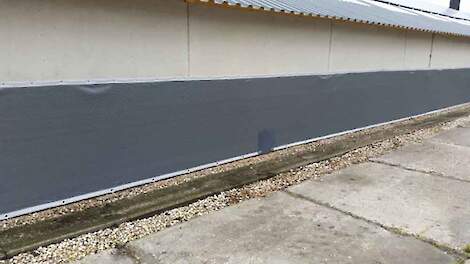Coarse particles and insects – which may be infected with avian influenza or other pathogens – can enter the air intakes of poultry farms along with the air. This emerged from research by Wageningen Bioveterinary Research (WBVR), part of Wageningen University & Research, and the University of Utrecht into potential vectors of avian influenza virus through the air intake. “Although we did not find an avian influenza virus in our research, we advise poultry farmers to take additional measures to reduce the potential risk of this introduction route via an air intake,” says WBVR researcher Armin Elbers. More research is needed to determine the effectiveness of the different measures.
Poultry can become infected with the avian influenza virus if there is direct or indirect contact with the feces or other secretions of infected wild birds or other infected poultry. The confinement obligation applied prevents direct contact between reared poultry and infected wild birds or infected environment. It is unclear how, despite the poultry farmer’s biosecurity measures and confinement obligation, poultry still become infected in some cases. various conceivable input methods; One by air through air inlet for poultry houses.
Commissioned by the Ministry of Agriculture, Nature and Food Safety, Wageningen Bioveterinary Research (WBVR) in Lelystad, in collaboration with the University of Utrecht (Faculty of Veterinary Medicine and Institute for Risk Assessment Sciences / IRAS), investigated the transfer of potential vectors of the virus through the air intake of a poultry farm.
Notes
In the newly infected poultry farm and laying poultry farm, after culling and various rounds of cleaning and disinfection, WBVR placed a ventilation hood over the inlet valve at 18 air inlets per house. A fine mesh net is also attached to it (see photo). The ventilation was turned on as if the poultry were present. The fine net collected wild bird feathers, plant matter, cobwebs, plastic, wool, and dung materials.
In addition, a video camera monitoring system was installed by WBVR. This recorded wild birds visiting the area around the stable.
the findings
The contents of the fine nets were harvested every 5 days in both poultry farms from January to March 2022 for a period of 25 days. Fine mesh was also wiped with a duster. Incoming materials, dusted and trapped insects were tested for influenza virus, campylobacter and salmonella. The insects have also been tested for Schmallenberg, West Nile and Usutu virus.
The researchers found small amounts of the material in the nets. These varied from small pieces of plants and/or crop materials, pieces of plastic and paper, to wool and spider web. No feathers or droppings from wild birds were observed. Cobwebs and plant material were observed the most: on average about 1 to 2 cobwebs or plant material per air intake per 5-day collection period. However, the difference in the amount of material entering through the different air inlets was significant. During the occasional storm with strong winds, large amounts of material can enter the home through the air inlets on the leeward side.
No virus found
All samples of the tested subjects were negative in a PCR test for influenza virus and salmonella. The insects tested negative for Schmallenberg, West Nile and Osoto viruses. Evidence of introduction of Campylobacter via air withdrawal has been found. The area within a short distance (up to 10 m) from the poultry houses was regularly visited by wild birds: Blackbird, Carrion Crow, Black-Back Null, Oystercatcher and Mallard Ducks.
continuation
The research indicates that coarse particles and insects – which may be contaminated with HPAI virus or other pathogens – can enter the air intakes of poultry along with the air. “It is therefore prudent to limit this potential pathway to submission,” says WBVR researcher Armin Elbers. However, more research is needed to understand how this can be done properly. “The use of a windbreak network may contribute to limiting this entry pathway,” Elbers predicts. He knows of a company that installed a windbreak a few years ago after a bird flu hit. That firm has now become infected again, likely from air supplied through the air inlet. Thus, a windbreak net is not a panacea.” According to Elbers, a good alternative is to use automated lasers. “Using lasers makes the area around the poultry house unattractive for visiting wild birds.”
An extra line of defense
Piet Faber, promoter in Nijerberkoop (French) and head of the LTO / NOP-NVP deployment steering group, has been advising for some time the installation of a windbreak network in particular. “With windbreak nets, feathers can be stopped and pollution prevented. As poultry farmers, we have arranged entry at the door very well. We have not yet arranged anything to prevent entry through ventilation. I see this as an extra line of defense.” This year’s outbreaks also show that businesses don’t just get infected through the air.
The researchers published their findings in the scientific article ‘Monitoring of windborne particles entering poultry farms through the air intake: highly pathogenic avian influenza virus and risks for other pathogensIn the Journal of Pathogens.

“Total coffee specialist. Hardcore reader. Incurable music scholar. Web guru. Freelance troublemaker. Problem solver. Travel trailblazer.”







More Stories
GALA lacks a chapter on e-health
Weird beer can taste really good.
Planets contain much more water than previously thought